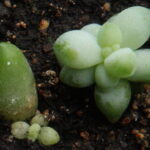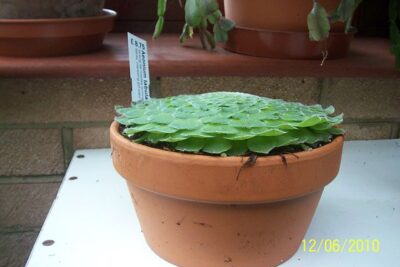
Exploring Root Depths in Succulents: Understanding Root Growth

Root depth is an important aspect of plant growth that plays a crucial role in the health and survival of plants. In the case of succulents, understanding their root depths is particularly important due to their unique water storage capabilities and adaptation to arid environments. Succulents have gained popularity as houseplants and outdoor ornamentals due to their striking appearance and low maintenance requirements. However, to ensure their successful growth and longevity, it is essential to have a good understanding of their root growth patterns and requirements.
We will delve into the world of succulent root depths and explore the factors that influence their growth. We will discuss the anatomy of succulent roots and how they differ from other plant species. Additionally, we will examine the impact of various environmental factors such as soil type, watering practices, and container size on root growth. By gaining a deeper understanding of succulent root depths, we can provide optimal care for these plants and help them thrive in our indoor and outdoor environments.
- Water succulents sparingly to promote deeper root growth
- Use well-draining soil to encourage roots to grow deeper
- Provide succulents with enough sunlight to stimulate root growth
- Avoid overpotting succulents to prevent shallow root growth
- Gradually increase watering frequency to encourage roots to search for water deeper in the soil
- Use root-promoting fertilizers to stimulate root growth in succulents
- Gently loosen the soil around succulents to encourage root expansion
- Avoid excessive pruning to allow roots to fully develop in succulents
- Monitor and adjust watering practices based on the specific needs of each succulent species
- Provide proper ventilation to prevent root rot and promote healthy root growth in succulents
- Frequently Asked Questions
Water succulents sparingly to promote deeper root growth
When it comes to watering succulents, less is often more. Unlike other plants, succulents have adapted to survive in arid environments by storing water in their leaves and stems. Their unique ability to retain moisture allows them to thrive in regions with minimal rainfall. However, this also means that they have specific watering needs that differ from traditional houseplants.
To encourage deeper root growth in succulents, it's crucial to water them sparingly. Overwatering can lead to shallow root systems, making the plants more susceptible to rot and disease. By allowing the soil to dry out between waterings, you'll prompt the succulents to send their roots deeper in search of moisture.
Understanding root growth in succulents
Succulents have a fascinating root system that adapts to their arid habitat. Their roots are shallow and widespread, allowing them to quickly absorb any available moisture. However, these shallow roots are also prone to drying out, making it essential to water succulents properly.
When you water a succulent, the moisture soaks into the soil, and the roots begin to absorb it. As the water is gradually used up by the plant, the soil begins to dry out. This drying of the soil signals to the succulent that it's time to seek more moisture.
 Vertical Succulents: Discover Which Types Grow Straight Up
Vertical Succulents: Discover Which Types Grow Straight UpAs the roots continue to grow, they extend deeper into the soil, exploring new depths in search of water. The process of root growth in succulents is driven by the plant's need for survival. By sending their roots deeper, succulents can access water that may be more deeply rooted in the soil, ensuring their continued growth and survival.
Tips for promoting deeper root growth
To promote healthy root growth in your succulents, follow these tips:
- Water sparingly: Allow the soil to dry out completely before watering again. This encourages the roots to grow deeper in search of moisture.
- Use well-draining soil: Succulents thrive in soil that drains quickly, preventing water from pooling around the roots and causing rot.
- Choose the right container: Opt for a pot with drainage holes to ensure excess water can escape, preventing waterlogged soil.
- Provide adequate sunlight: Succulents need bright light to photosynthesize and grow. Place them in a sunny spot to support healthy root development.
- Monitor temperature and humidity: Succulents prefer warm and dry environments, so avoid exposing them to excessive moisture or cold temperatures.
By following these guidelines, you'll create an environment that encourages your succulents to develop strong and resilient root systems. Remember, the key is to mimic their natural habitat and provide the conditions that will promote their overall health and growth.
Use well-draining soil to encourage roots to grow deeper
When it comes to growing healthy and thriving succulents, understanding root growth is key. One important aspect to consider is the depth at which succulent roots grow. By encouraging roots to grow deeper, you can help your succulents develop a strong and robust root system. One effective way to achieve this is by using well-draining soil.
Unlike many other plants, succulents have adapted to survive in arid environments with limited water availability. As a result, their roots have evolved to be efficient in absorbing water from the soil. Succulent roots tend to grow deep into the ground in search of water sources, allowing them to withstand drought conditions.
By providing your succulents with well-draining soil, you can mimic their natural habitat and encourage root growth. Well-draining soil allows excess water to flow through easily, preventing the roots from sitting in waterlogged conditions. This promotes the development of longer and stronger roots as the plant seeks water deeper in the soil.
A simple recipe for well-draining soil is to mix equal parts of regular potting soil, coarse sand, and perlite. This combination creates a porous and lightweight medium that allows water to pass through quickly. Avoid using heavy or compacted soil, as it can hinder root growth and lead to root rot.
 Can Succulents Easily Spread and Overrun Gardens?
Can Succulents Easily Spread and Overrun Gardens?Tip: When repotting your succulents, choose a container with drainage holes to ensure excess water can escape, further promoting root growth.
Provide adequate water, but do not overwater
While it is important to encourage roots to grow deeper, it is equally crucial to provide succulents with adequate but controlled water. Overwatering can lead to root rot and ultimately damage the root system.
Succulents have adapted to store water in their leaves and stems, enabling them to survive for extended periods without irrigation. They are more susceptible to root rot caused by excess moisture, as their roots are not accustomed to constantly wet conditions.
To promote root growth without risking overwatering, water your succulents thoroughly but infrequently. Allow the soil to dry out completely between waterings, and then water deeply until the excess water drains out from the bottom of the pot. This will encourage the roots to grow deeper in search of water, while also preventing waterlogged conditions.
Tip: To check if your succulents need watering, stick your finger about an inch into the soil. If it feels dry at that depth, it's time to water.
- Water your succulents thoroughly but infrequently
- Allow the soil to dry out completely between waterings
- Water deeply until excess water drains out from the bottom of the pot
By following these guidelines and understanding the importance of root depth in succulents, you can create optimal conditions for your plants to thrive. Encouraging root growth not only improves the overall health of your succulents but also enhances their ability to withstand periods of drought. So, give your succulents the opportunity to grow deep roots, and watch them flourish!
Provide succulents with enough sunlight to stimulate root growth
Succulents are known for their ability to thrive in dry and arid conditions. One important factor in ensuring the health and growth of succulents is providing them with enough sunlight. Sunlight is crucial for stimulating root growth in succulents.
 Step-by-Step Guide to Propagating Bear Paw Succulent from a Leaf
Step-by-Step Guide to Propagating Bear Paw Succulent from a LeafWhen succulents are exposed to sunlight, they undergo a process called photosynthesis. During photosynthesis, succulents convert sunlight into energy, which is then used for various biological processes, including root growth. Sunlight provides succulents with the necessary energy to produce and expand their root systems.
In order to ensure optimal root growth, it is essential to place your succulents in a location where they can receive at least 6 hours of direct sunlight per day. This can be achieved by placing them near a south-facing window or outdoors in a sunny spot. If you are growing succulents indoors, you may also consider using artificial grow lights to supplement their sunlight exposure.
It's important to note that while succulents require sunlight for root growth, excessive exposure to intense sunlight can be harmful. Succulents can become sunburned if exposed to prolonged periods of intense sunlight, leading to damage and stunted root growth. Therefore, it's crucial to strike a balance and provide them with the right amount of sunlight.
In addition to sunlight, succulents also require well-draining soil to promote healthy root growth. Succulents are adapted to survive in arid environments, and their roots are designed to absorb water quickly and efficiently. Using a well-draining soil mix, such as a combination of potting soil, perlite, and coarse sand, allows excess water to drain away, preventing root rot and promoting root growth.
Avoid overpotting succulents to prevent shallow root growth
When it comes to succulents, understanding their root growth is crucial for their overall health and well-being. One common mistake that many succulent enthusiasts make is overpotting their plants. While it may seem like a generous gesture to give your succulent plenty of room to grow, overpotting can actually lead to shallow root growth.
Shallow root growth occurs when the roots of a succulent do not penetrate deep into the soil. Instead, they tend to spread out horizontally near the surface. This can have detrimental effects on the plant's stability and ability to absorb nutrients and water.
To avoid shallow root growth, it is important to choose an appropriate pot size for your succulent. A pot that is slightly larger than the root ball of the plant is ideal. This allows the roots to have enough space to spread out without being overwhelmed by excess soil.
 Propagating Succulent Leaves: A Guide to Growing New Plants
Propagating Succulent Leaves: A Guide to Growing New PlantsAdditionally, using a well-draining soil mix is essential for promoting healthy root growth in succulents. The soil should be able to retain enough moisture for the roots to absorb but also allow excess water to drain away quickly. This prevents the roots from sitting in water for extended periods, which can lead to root rot and shallow root growth.
Regularly inspecting the root system of your succulent can also provide valuable insights into its health. Gently remove the plant from its pot and examine the roots. Healthy roots should be firm, white, and well-distributed throughout the soil. If you notice a significant amount of shallow roots, it may be time to repot your succulent into a slightly larger container.
Avoiding overpotting and providing an appropriate pot size and well-draining soil mix are vital for preventing shallow root growth in succulents. By understanding the importance of root depth, you can ensure the long-term health and vitality of your beloved succulent collection.
Gradually increase watering frequency to encourage roots to search for water deeper in the soil
Succulents are known for their ability to store water in their fleshy leaves, stems, or roots. However, to ensure their long-term survival, it is important to promote healthy root growth. By gradually increasing the watering frequency, you can encourage your succulents' roots to search for water deeper in the soil.
When succulents are watered infrequently, their roots tend to stay near the soil surface where water is most readily available. This shallow root system may not be able to access water during dry periods, leading to stress and potential damage to the plant.
To encourage deeper root growth, start by watering your succulents less frequently than usual. Allow the soil to dry out completely between waterings, but be mindful not to let it become bone dry. This will signal to the roots that water is becoming scarcer, and they will begin to grow deeper in search of moisture.
 Can You Propagate Donkey's Tail Succulent with Leaf Cuttings?
Can You Propagate Donkey's Tail Succulent with Leaf Cuttings?After a few weeks of infrequent watering, gradually increase the frequency. Water your succulents more often, but still ensure that the soil dries out between waterings. This gradual increase in watering frequency will continue to stimulate root growth and encourage the development of a robust root system.
It is important to mention that while promoting deep root growth is beneficial for succulents, overwatering can still be detrimental. Always check the moisture level of the soil before watering and adjust the frequency accordingly.
Benefits of encouraging deep root growth in succulents:
- Enhanced drought tolerance: Succulents with deep roots are better equipped to withstand dry periods as their roots can access water stored deeper in the soil.
- Improved nutrient uptake: Deeper roots allow succulents to access a wider range of nutrients present in the soil.
- Stability and anchorage: A robust root system provides stability to the plant, preventing it from toppling over in windy conditions.
- Healthier overall growth: By promoting deep root growth, succulents can achieve overall better health and vitality.
By understanding the importance of root growth and implementing proper watering techniques, you can ensure the long-term success of your succulents. Encouraging deep root growth will not only make your plants more resilient but also enhance their overall beauty and longevity.
Use root-promoting fertilizers to stimulate root growth in succulents
When it comes to succulent care, understanding root growth is essential. Succulents have a unique ability to store water in their leaves, stems, and roots, allowing them to survive in arid environments. However, to ensure the health and longevity of your succulents, it is crucial to promote proper root development.
Succulent roots play a vital role in absorbing water and nutrients from the soil, providing stability to the plant, and storing reserves for times of drought. By stimulating root growth, you can enhance the overall well-being and resilience of your succulents.
Choosing the right fertilizer
When selecting a fertilizer to promote root growth in succulents, it is important to look for products that are specifically designed for these plants. Opt for a well-balanced fertilizer with a higher phosphorus content, as phosphorus is known to stimulate root development.
 Succulent Propagation: Home Techniques for Thriving Varieties
Succulent Propagation: Home Techniques for Thriving VarietiesAdditionally, consider using organic fertilizers or slow-release granules, as they provide a steady supply of nutrients to the roots over an extended period. This allows for gradual and sustained root growth, preventing the risk of over-fertilization.
Applying the fertilizer
Before applying the fertilizer, make sure your succulents are well-watered. This helps prevent root burn and ensures that the nutrients are evenly distributed throughout the soil.
Start by diluting the fertilizer according to the manufacturer's instructions. Remember, succulents are adapted to survive in nutrient-poor soil, so it is essential not to over-fertilize. Using a watering can or spray bottle, apply the fertilizer to the soil around the base of the plant, avoiding direct contact with the leaves.
It is important to note that succulents have sensitive roots, so it is advisable to use a weak fertilizer solution. Diluting the fertilizer to half or a quarter of the recommended strength is a good rule of thumb.
Frequency of fertilization
When it comes to fertilizing succulents to promote root growth, less is often more. Over-fertilizing can lead to root burn and other issues, so it is crucial to strike the right balance.
Aim to fertilize your succulents during their active growing season, typically in spring and summer. During this time, you can apply the fertilizer every four to six weeks. In contrast, reduce or stop fertilizing during the dormant period in fall and winter, as succulents require less nutrients during this time.
Observing your succulents closely is key. If you notice signs of over-fertilization, such as burned or discolored leaves, reduce the frequency or concentration of the fertilizer.
 Fast-Spreading and Prolific Succulents: A Guide to Rapid Propagation
Fast-Spreading and Prolific Succulents: A Guide to Rapid PropagationBy using root-promoting fertilizers and following these guidelines, you can ensure that your succulents develop strong and healthy root systems. Remember, a well-established root system is the foundation for thriving succulents that will bring beauty and joy to your indoor or outdoor space.
Gently loosen the soil around succulents to encourage root expansion
Gently loosen the soil around succulents to encourage root expansion
Succulents are known for their ability to thrive in arid conditions, thanks to their unique water-storing leaves. However, many people overlook the importance of root growth when it comes to the overall health and longevity of these plants. Understanding the root depths of succulents is crucial for providing them with the optimal environment to grow and flourish.
One effective method to encourage root expansion in succulents is by gently loosening the soil around their base. This helps to create a looser and more aerated environment for the roots to spread and explore. The loosening of the soil also aids in preventing compaction, which can hinder root growth and nutrient uptake.
When loosening the soil around succulents, it is important to be cautious and gentle to avoid damaging the delicate root systems. Start by using a small gardening tool, such as a hand fork or a trowel, to carefully loosen the soil around the base of the plant. Work your way around the plant, being mindful not to disturb the roots excessively.
Additionally, it is crucial to avoid over-watering succulents, as excessive moisture can lead to root rot and other issues. Succulents are adapted to survive in dry conditions, so they do not require frequent watering. Instead, water them sparingly and allow the soil to dry out completely between watering sessions. This helps to promote deep root growth as the plants search for water deeper in the soil.
Furthermore, providing succulents with well-draining soil is essential for root growth. Opt for a potting mix specifically formulated for succulents or create your own by combining equal parts of potting soil, perlite, and coarse sand. This mix allows excess water to drain away quickly, preventing the roots from sitting in damp conditions for extended periods.
 Can Succulent Leaves Regrow Once They Drop?
Can Succulent Leaves Regrow Once They Drop?Key Points:
- Gently loosen the soil around succulents to encourage root expansion and prevent compaction.
- Be cautious and gentle when loosening the soil to avoid damaging the delicate root systems.
- Avoid over-watering succulents to prevent root rot and promote deep root growth.
- Use well-draining soil or a succulent-specific potting mix to provide an optimal growing environment for the roots.
By understanding the importance of root growth in succulents and implementing these strategies, you can create a thriving environment for your plants. Encouraging root expansion not only improves the overall health of succulents but also enhances their ability to withstand drought conditions and thrive in various environments.
Avoid excessive pruning to allow roots to fully develop in succulents
When it comes to succulents, many plant enthusiasts focus primarily on the stunning foliage and unique growth patterns. However, it is important not to overlook the hidden world beneath the surface – the roots.
The root system of a succulent plays a crucial role in its overall health and growth. Understanding root growth and providing the right conditions for it can greatly benefit the plant's long-term well-being. One essential aspect to consider is the depth at which succulent roots grow.
Why is root depth important?
The depth at which succulent roots grow is directly related to their ability to access water and nutrients. Unlike other plant species, succulents have adapted to survive in arid environments by storing water in their leaves, stems, or roots. Therefore, their roots tend to grow deeper to search for water sources underground.
By understanding the natural root depth of succulents, we can better replicate their native environment and provide optimal conditions for their growth. This knowledge also helps us avoid common mistakes, such as excessive pruning, which can hinder root development.
 Can Succulent Leaves Grow Roots When Planted in Soil?
Can Succulent Leaves Grow Roots When Planted in Soil?How to encourage root development in succulents
To ensure healthy root growth in your succulents, consider the following tips:
- Choose the right pot: Select a pot with proper drainage to avoid waterlogged soil, which can lead to root rot. A shallow pot with ample width is ideal to allow roots to spread out.
- Use well-draining soil: Opt for a well-draining soil mix specifically formulated for succulents. This will prevent excess moisture and promote healthy root growth.
- Water deeply but infrequently: Water your succulents thoroughly, allowing the water to reach the root zone. However, avoid overwatering, as this can cause root suffocation and rot.
- Provide adequate sunlight: Succulents thrive in bright, indirect sunlight. Place them near a window or in a spot where they can receive at least 6 hours of sunlight per day.
- Avoid excessive pruning: Pruning is necessary for maintaining the shape and size of succulents, but excessive pruning can hinder root development. Allow your succulents to grow naturally, allowing their roots to fully develop.
By following these guidelines, you can create an environment that encourages robust root growth in your succulents. Remember, healthy roots are the foundation for a thriving plant!
Monitor and adjust watering practices based on the specific needs of each succulent species
Understanding the Importance of Root Depth
When it comes to succulents, understanding the root depth is crucial for their overall health and growth. The root system of a succulent plays a vital role in absorbing water and nutrients from the soil. By exploring the root depths of different succulent species, you can gain insight into their specific watering needs and ensure their optimal growth.
Factors Affecting Root Depth
The root depth of succulents can vary depending on various factors, including the species, age of the plant, and the environment in which they are grown. Generally, succulents have shallow root systems that spread out horizontally rather than digging deep into the ground.
Determining Root Depth
 Can Succulent Leaves Regrow Once they Fall Off?
Can Succulent Leaves Regrow Once they Fall Off?One way to determine the root depth of a succulent is by examining its growth pattern. If you notice that the plant has numerous offshoots or pups growing around its base, it indicates a shallow root system. On the other hand, succulents with a single, strong central stem often have deeper root systems.
Another method to determine root depth is by carefully removing the plant from its pot. Gently shake off excess soil and examine the roots. If the roots are concentrated near the surface and form a dense mat, it suggests a shallow root system. Conversely, if the roots extend deeply into the soil, it indicates a deeper root system.
Implications for Watering Practices
The root depth of succulents has implications for their watering practices. Succulents with shallow root systems are more prone to overwatering as their roots can easily rot if sitting in waterlogged soil. Therefore, it is important to water shallow-rooted succulents sparingly and allow the soil to dry out completely between waterings.
On the other hand, succulents with deeper root systems can tolerate longer periods of drought as their roots can reach deeper into the soil to access water. However, this does not mean they should be neglected. It is still essential to provide adequate water when the soil is dry, but avoid overwatering to prevent root rot.
Understanding the root depths of succulents is key to their proper care and growth. By monitoring and adjusting your watering practices based on the specific needs of each succulent species, you can ensure healthy root growth and overall thriving succulents.
Provide proper ventilation to prevent root rot and promote healthy root growth in succulents
Proper ventilation is crucial for the health and well-being of your succulents, especially when it comes to their root growth. Succulents have specialized root systems that are adapted to thrive in arid conditions. Understanding how root growth works in succulents will help you create an optimal environment for their development.
The Importance of Ventilation
Ventilation plays a vital role in preventing root rot, which is one of the most common issues faced by succulent growers. Succulents store water in their leaves and stems, making them more susceptible to root rot if the soil remains too moist for extended periods. Adequate airflow around the roots helps to prevent the accumulation of excess moisture and encourages healthy root growth.
Root Growth in Succulents
Succulents have a unique type of root system known as a fibrous root system. Unlike plants with taproots that grow deep into the ground, succulents develop shallow and widespread root systems. These shallow roots allow them to quickly absorb water from the soil surface after rainfall and store it for future use.
When provided with proper ventilation, the roots of succulents can access the oxygen they need to facilitate respiration. This enables the roots to effectively absorb nutrients from the soil and support the overall growth and health of the plant.
Ways to Promote Healthy Root Growth
To ensure optimal root growth in your succulents, here are some tips:
- Use well-draining soil: Succulents require soil that allows excess water to flow out easily. Choose a well-draining soil mixture specifically formulated for succulents or create your own by adding perlite or sand to regular potting soil.
- Provide adequate drainage: Ensure that your succulent containers have drainage holes to prevent water from pooling at the bottom, causing root rot.
- Avoid overwatering: Succulents are drought-tolerant plants and do not require frequent watering. Allow the soil to dry out completely between waterings to prevent root rot.
- Place in a well-ventilated area: Position your succulents in a location with good air circulation, such as near an open window or a fan. This will help prevent the build-up of excess moisture around the roots.
By following these guidelines, you can create a suitable environment for your succulents to thrive and promote healthy root growth. Remember, proper ventilation is key to preventing root rot and ensuring the longevity of your succulents.
Frequently Asked Questions
1. How deep do succulent roots grow?
Succulent roots typically grow shallow, usually within the top 2-4 inches of soil.
2. Do succulents have taproots?
No, most succulents do not have taproots. They have fibrous roots that spread out horizontally instead.
3. Can succulent roots damage pipes or structures?
In general, succulent roots are not strong enough to cause damage to pipes or structures. However, it's always a good idea to be cautious and keep an eye on their growth near such areas.
4. How often should I water succulents to encourage root growth?
Succulents thrive in well-draining soil, so it's important to water them thoroughly but infrequently. Allow the soil to dry out completely between waterings to encourage healthy root growth.
If you want to read more articles similar to Exploring Root Depths in Succulents: Understanding Root Growth, you can visit the Propagation category.






You Must Read